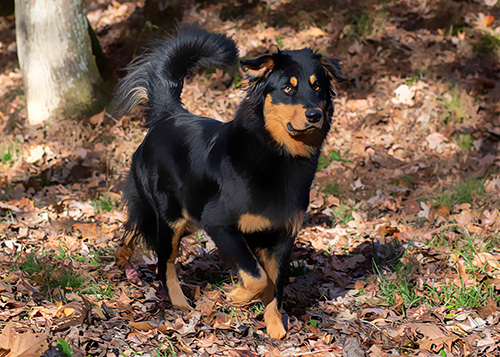
“Pete The Mountain Dog,” written by Mr. Walter W. Oglivie of Allisona, Tennessee, was originally published c. 1950 in the English Shepherd Club of America Who’s Who Breeder Manual on Pages 25-27. The article provides a nostalgic and detailed account of Oglivie’s experiences with English Shepherds, specifically a dog named Pete, and their role in his farming and cattle herding activities. Here is a narrative analysis of its key themes and insights:
1. Early Experiences and the Influence of Uncle Pete:
Oglivie recalls his early experiences with cattle herding alongside Uncle Pete in the Cumberland Mountain range. Uncle Pete’s expertise in the region and his pair of “Mountain Shepherd Dogs” significantly influenced Oglivie’s perception of the breed. This backstory sets a foundation for his appreciation of English Shepherds’ herding abilities.
2. Pete’s Training and Skills:
The dog Pete, whom Oglivie brought home from Uncle Pete, exhibited exceptional herding skills and an almost human-like understanding of cattle and sheep. The author’s admiration for Pete’s intelligence and working ability is a central theme, emphasizing the breed’s inherent instincts and capabilities.
3. Comparison with Other Breeds and the Unmatched Qualities of Pete:
Oglivie compares his subsequent experience with various stock dogs to Pete, finding none that matched Pete’s caliber. This comparison highlights the exceptional qualities he found in Pete, setting a high standard for working dogs.
4. Introduction to Registered English Shepherds:
About twelve months before writing the article, Oglivie discovered registered black and tan English Shepherds through an advertisement. His visit to the Blankenships in Murfreesboro, Tennessee, marked the beginning of his involvement with the breed. He acquired a dog named Bozo and a female named Shag, noting their resemblance to Pete.
5. Training and Working with English Shepherds:
Oglivie describes his experience working with his new English Shepherds, especially in herding steers. He notes their natural heeling instinct and intelligence, along with the training he provided, which made them effective working dogs. Oglivie speaks specifically to using his dogs to drive steers across narrow mountain paths and to load the livestock into rail cars.
6. Future Prospects and Promotion of the Breed:
An upcoming rodeo in Franklin, Tennessee, where the Blankenships and Oglivie planned to exhibit the working capabilities of their English Shepherds, is mentioned. This event represents a significant opportunity to showcase the breed’s abilities to a wider audience.
7. Personal Life and Connection to Farming:
Oglivie shares insights into his family life and farm operations, illustrating his deep connection to the land and farming lifestyle. His fondness for riding horses and the integration of black and tan English Shepherds into his daily activities on the farm are highlighted.
Conclusion:
“Pete The Mountain Dog” is a compelling narrative that showcases the English Shepherd’s exceptional working abilities and the deep bond formed between these dogs and their owners. Oglivie’s personal story and experiences provide a vivid portrayal of the breed’s versatility, intelligence, and adaptability in farming and herding contexts. The article serves as a valuable first-person narrative of the enduring value and significance of English Shepherds in rural American life.
Read more about the history of Black and Tan English Shepherds